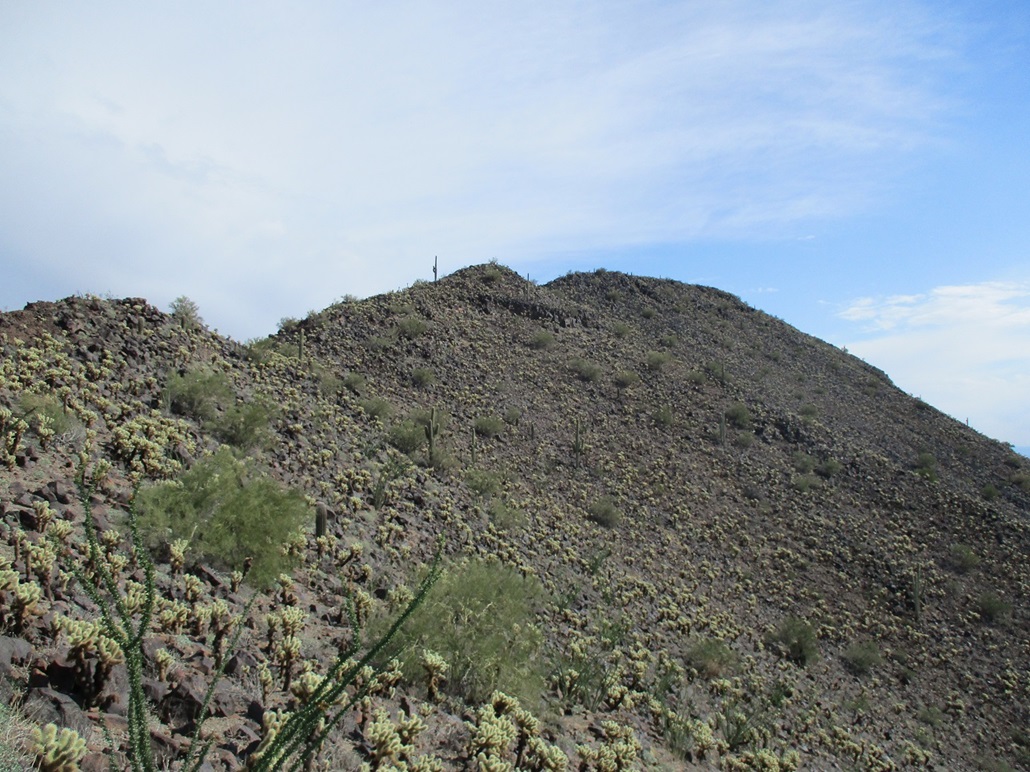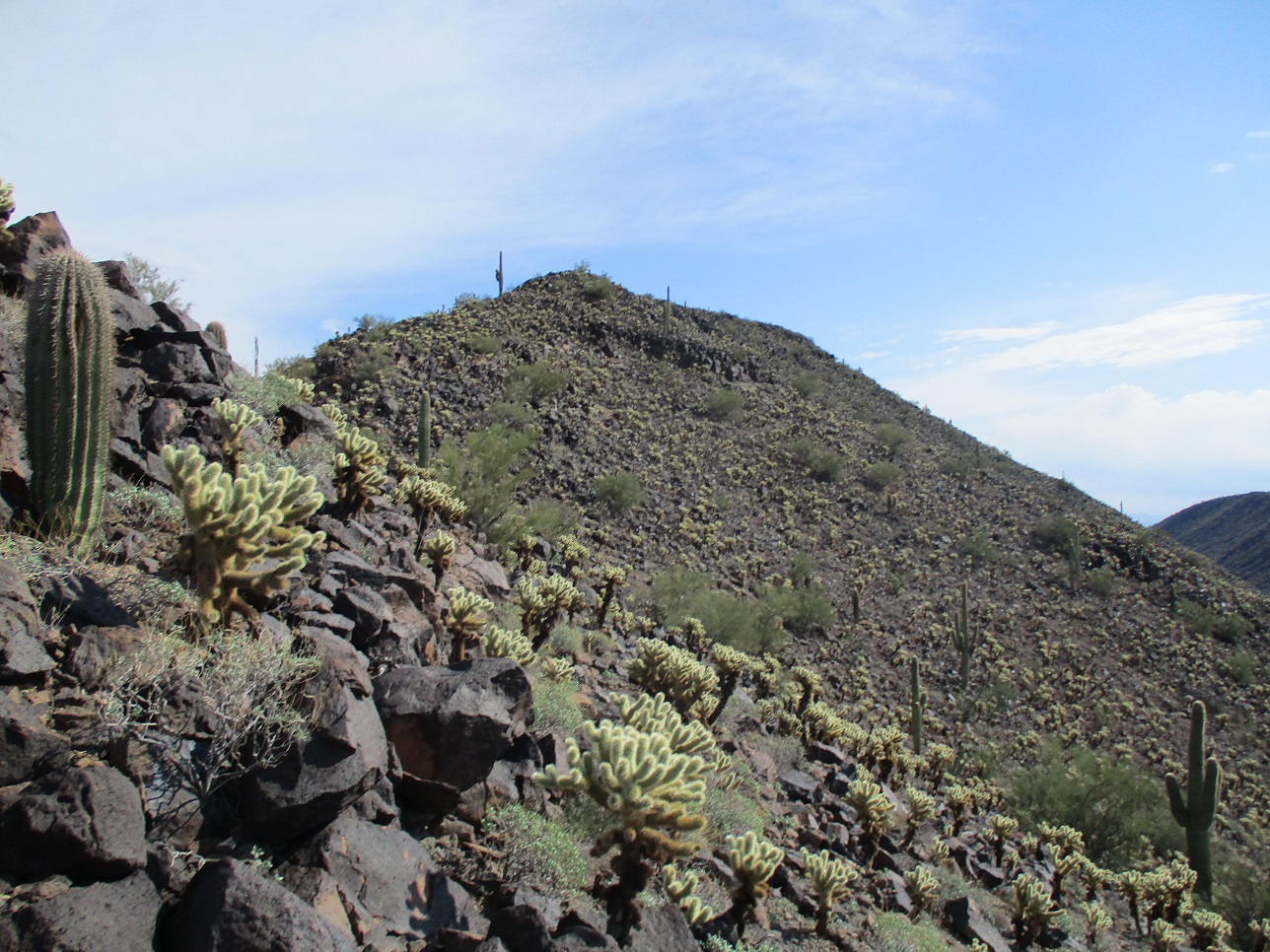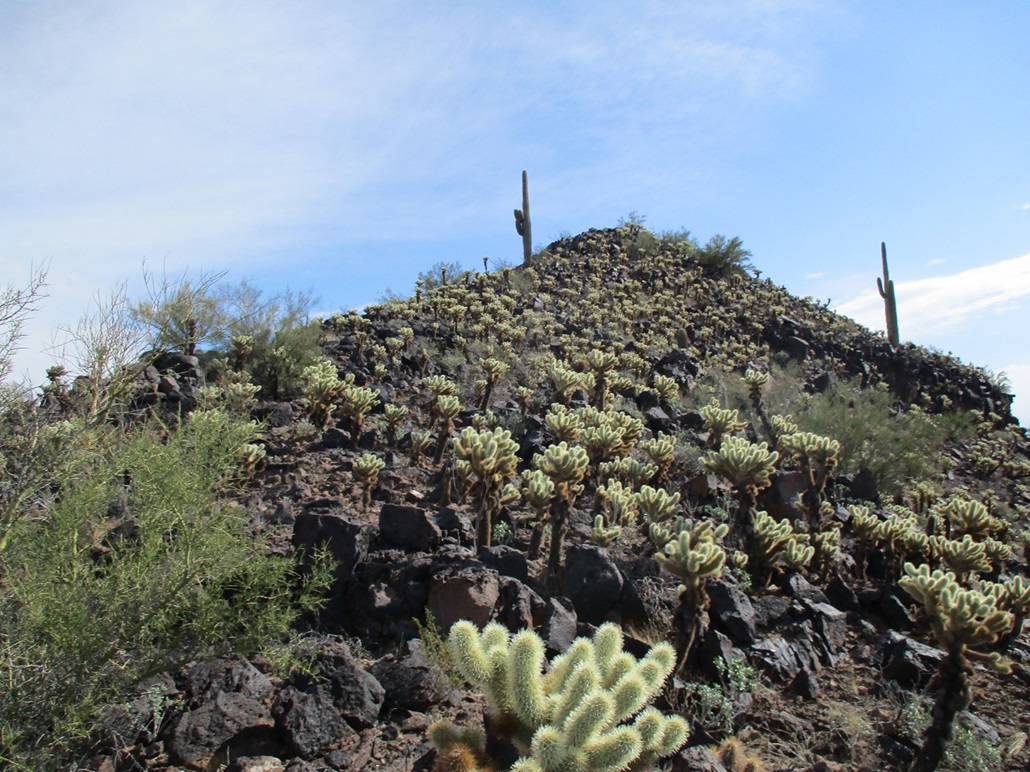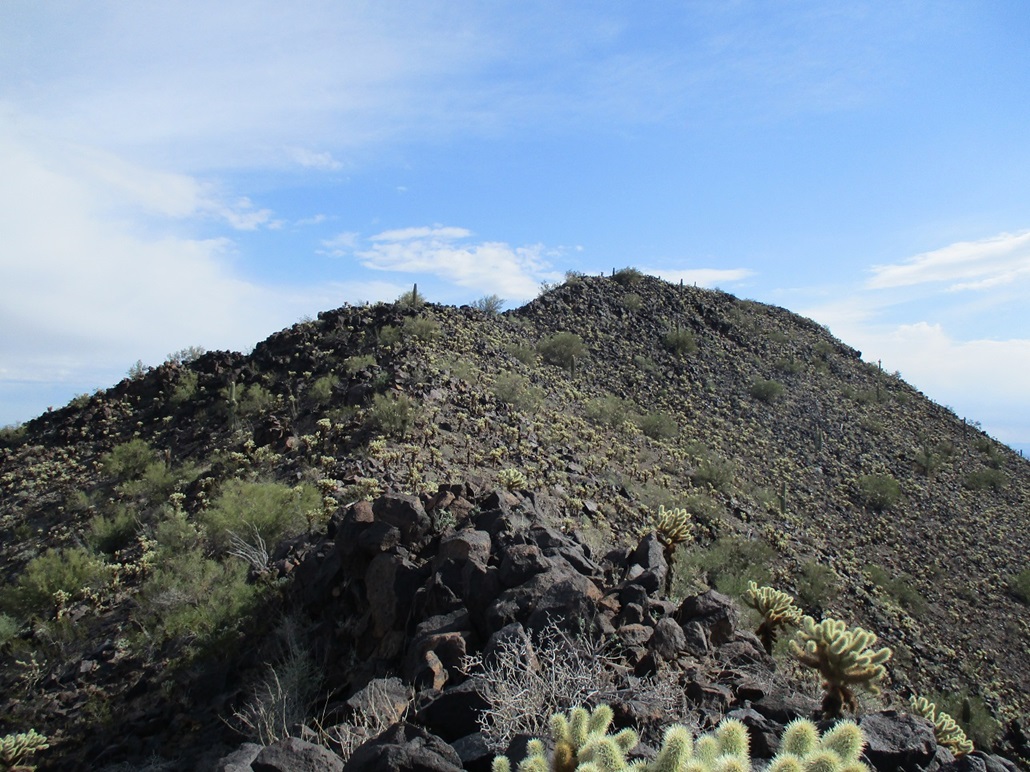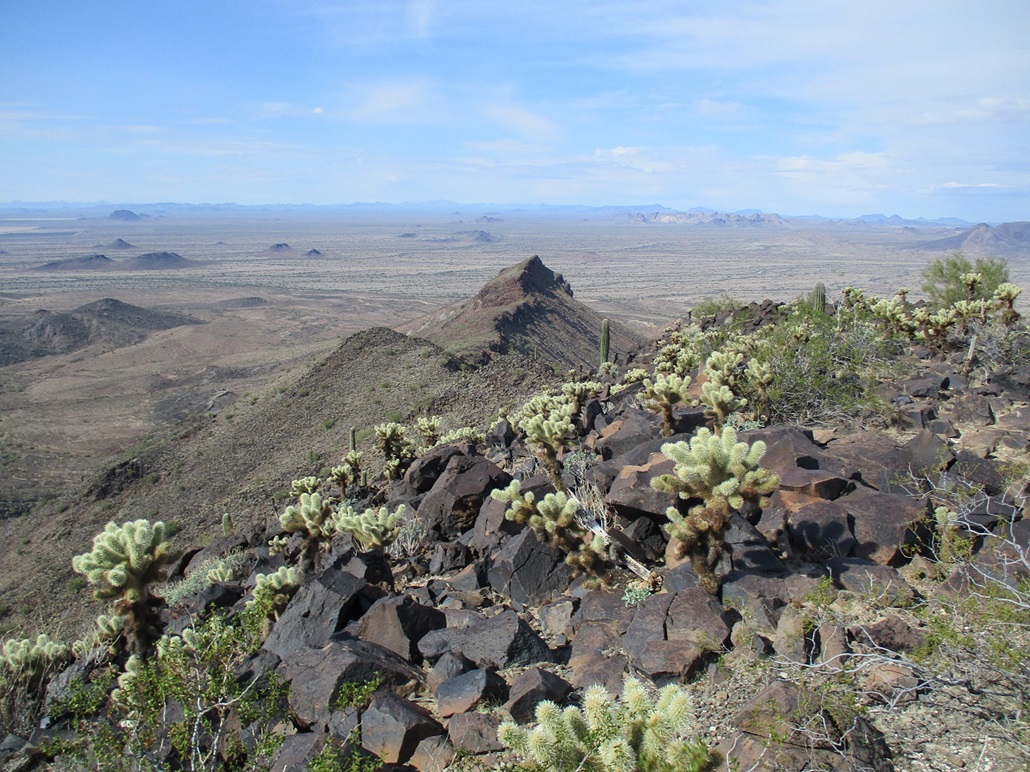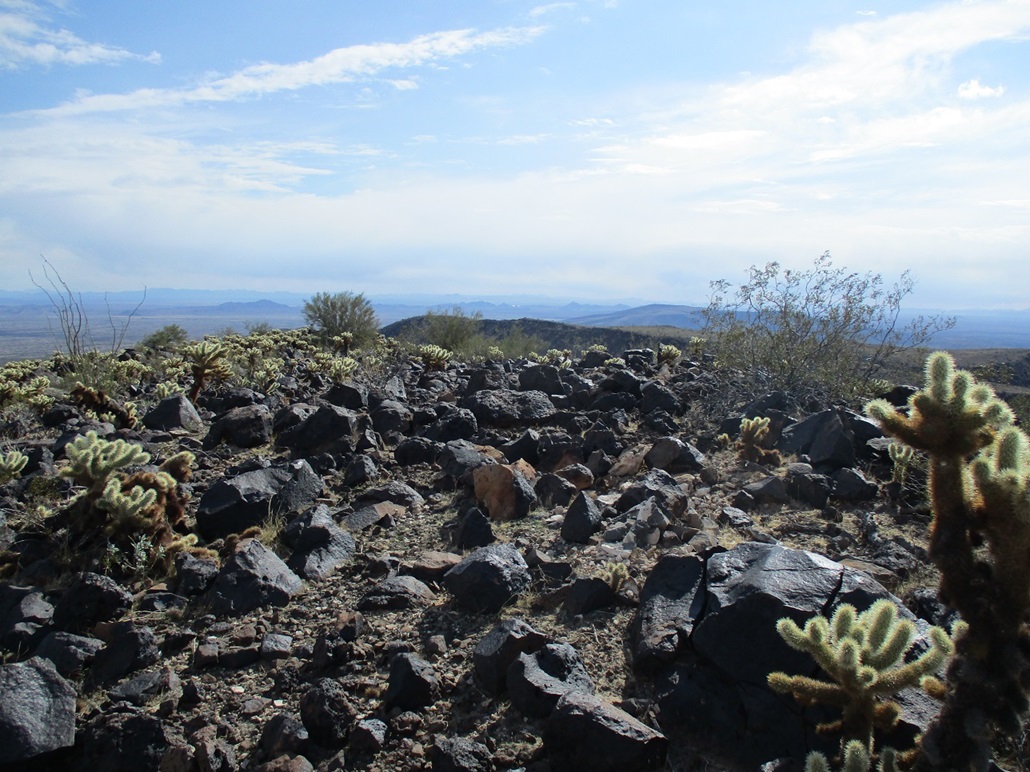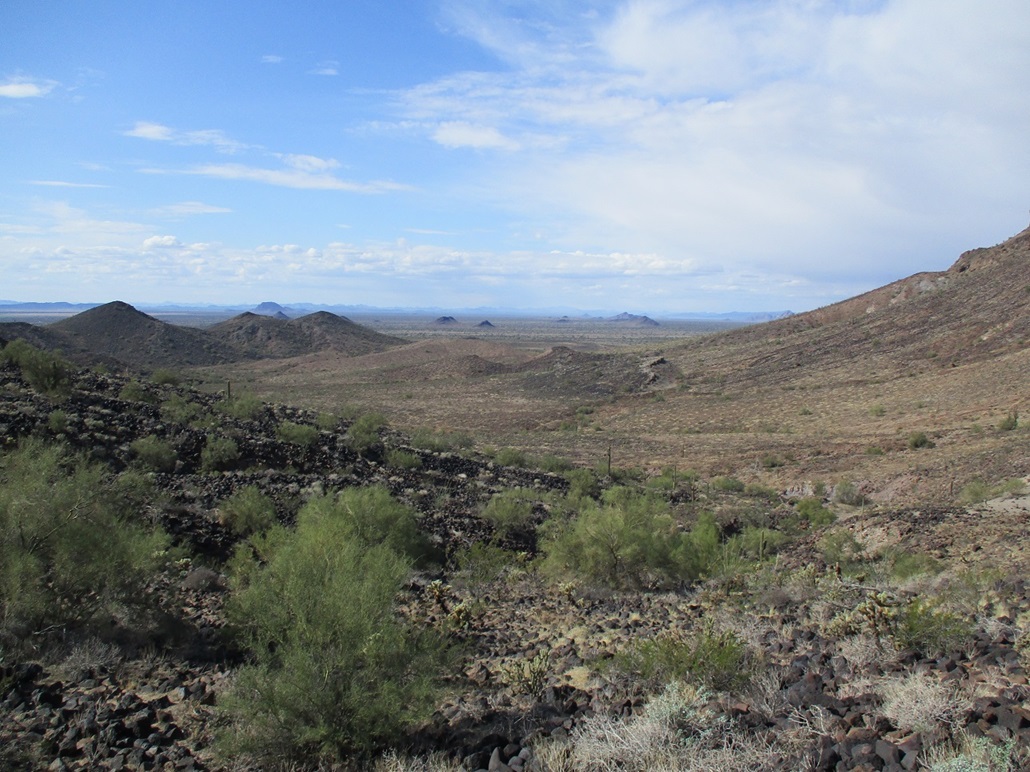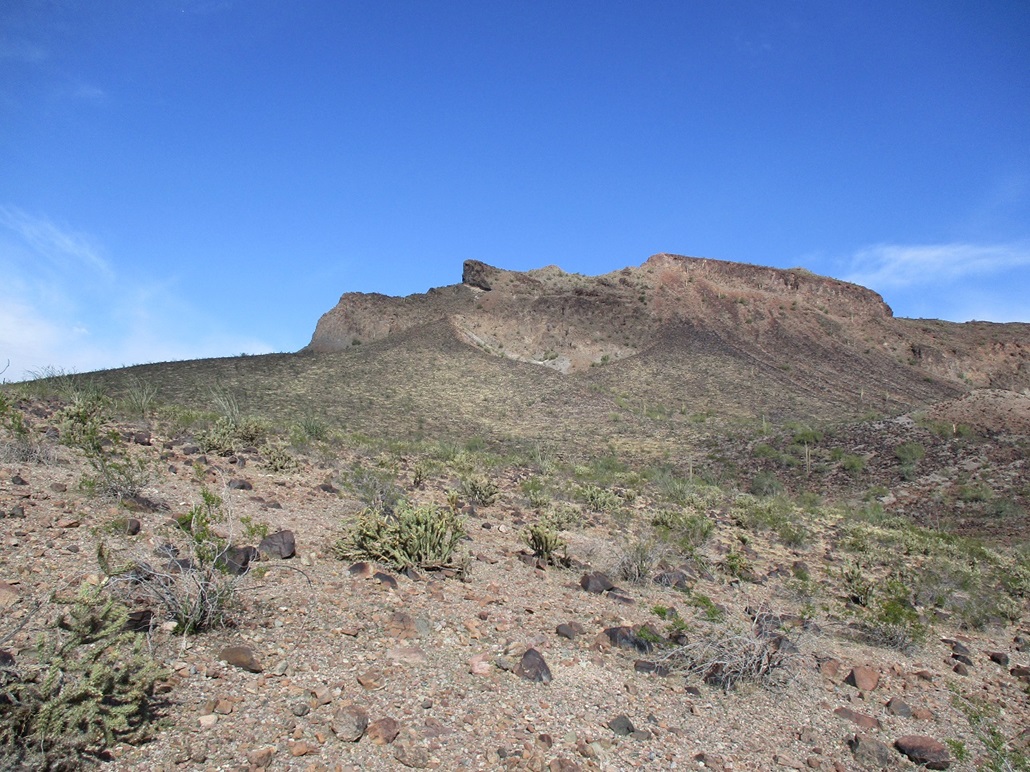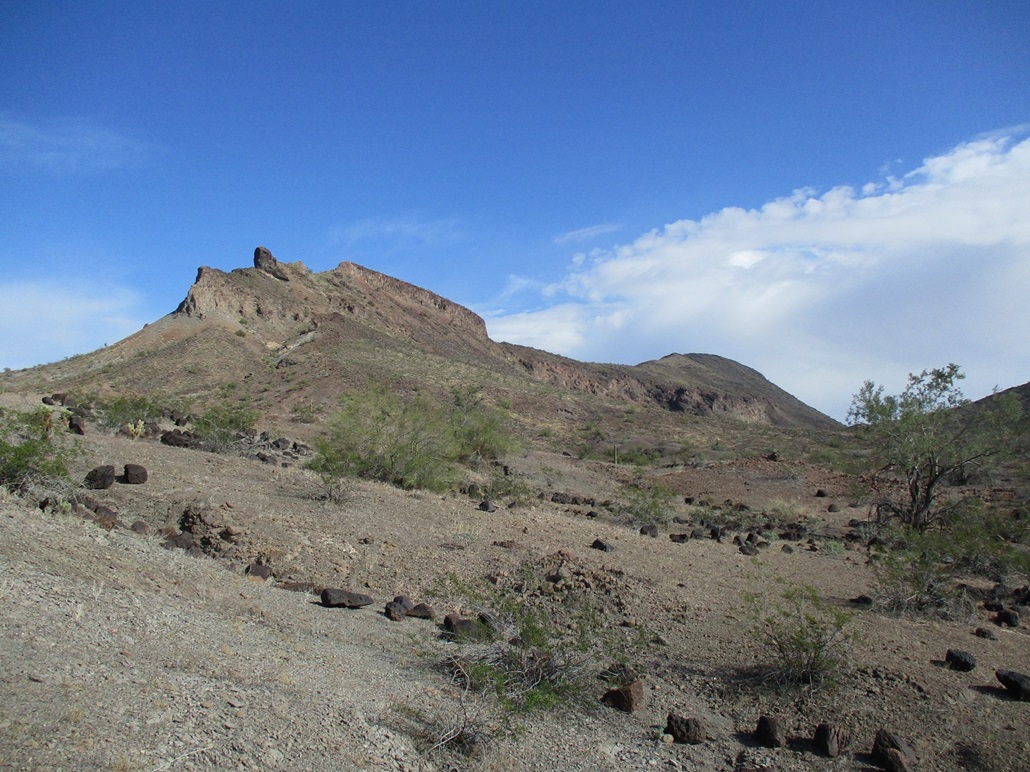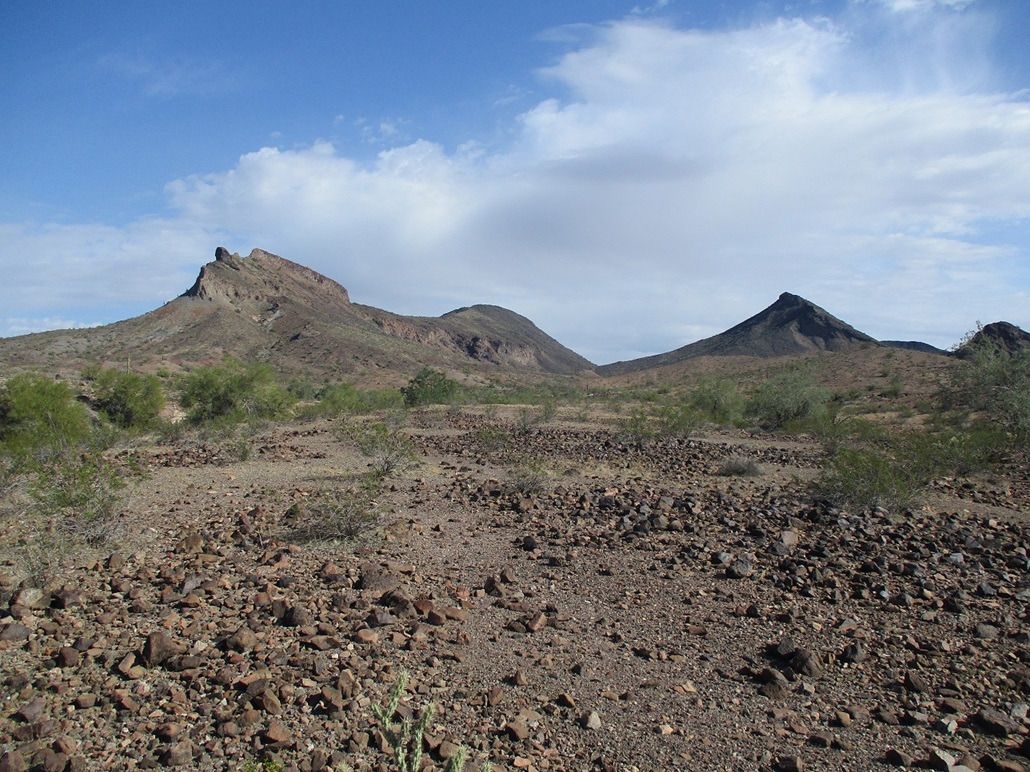
The Mountains of Arizona
• www.surgent.net
|
| Face Mountain |
• Highpoint: Face Mountain Complex • Hyder Valley • Maricopa County |
|
Date: January 22, 2022
• Elevation: 2,066 feet
• Prominence: 1,066 feet
• Distance: 8 miles
• Time: 4 hours, 40 minutes
• Gain: 1,226 feet
• Conditions: Cloudy and cool at first, then sunnier, then cloudy again
Arizona
•
Main
•
AZ P1K
•
PB
•
LoJ
Face Mountain is in southwest Maricopa County, northeast of the locale of Sentinel and north of Oatman Mountain. Agua Caliente Road gets close, passing the mountain about three miles to the west. There are no "Face Mountains" (plural) per se. The small collection of ridges and hills are collectively referred to as Face Mountain, in the singular form. The mountain(s) are volcanic mounds of black basalt boulders, with two main ridges (north and south) and an assortment of surrounding blobby hills. The mountain gets its name from a rocky outline on the west tip of the north ridge that looks like the profile of a face, with a chin, a prominent nose, a brow, and a "mohawk" hairstyle. This is called Montezuma Head. The highest point of Face Mountain lies on this north ridge, about a mile to the east.
Face Mountain was not on my radar when I set out this morning to tag a few peaks. I planned to climb the highpoint of the Painted Rock Mountains east of Gila Bend, then drive Interstate-8 east and tag a couple more lower ranked hills before heading home. I was up and on the road well before dawn, and in Gila Bend a little before 7 a.m., just the barest hints of light in the eastern horizon.
I drove Interstate-8 to the Painted Rock Exit, went north past a solar energy facility, then following the road northwest at a bend. Where the road bends north again, I eased onto a dirt road, heading west for two miles, driving on a solid dirt track on the edge of farm fields. I then went south on another farm track, then west into the open desert and parked at one last bend in the road near a berm and a culvert. It was now 7:45 a.m., the sun up but blocked by heavy clouds. It was chilly, in the low 40s.
I started walking southwest, aiming for the obvious highest point in the range. I walked about two miles across flat gravelly plain and occasional drainages to situate myself at the base of the main range massif. The sun was still behind the clouds and it was still cool, now drizzling slightly.
There did not seem to be an obvious way up from where I stood, so I hiked north about a half-mile past a side-ridge to see what I would find. I was hoping for some "back door" ramp that led to the range crest. I saw nothing, except for cliffs. I was losing interest fast, and did not want to be messing with scrambly rock in wet weather, although the drizzle never got worse. I decided to bail, do more homework, and come back another day. I walked back to my car. I covered about four miles with very little elevation gain. The walk went fast across the plain and I was gone for just over an hour. It was now a little past 9 a.m., still cloudy and cool.
Looking northwest, the clouds did not seem so thick. So I elected to drive that way and see what I would see. As a fail-safe, I could get onto Agua Caliente Road and tag a few peaks alongside it so that the day wasn't a total bust.
I got back onto the Painted Rock Road, following it west over a pass, north of Painted Benchmark. I then eased onto Rocky Point Road, drove past the actual Painted Rocks and the campground there. I drove past Oatman Mountain. and followed the wiggly road as it bent north, eventually connecting to Saddle Road, which is a frontage road that parallels the railroad. The Face Mountain Complex was up ahead. (If I am not allowed to say Face Mountains, then I'll say "Complex" because it sounds smart).
I drove southwest on Saddle Road a couple miles, then north onto an unmarked road. The online maps call it Agua Caliente Road, but moments later when I saw a sign, it is signed at 555th Avenue. This road heads north for 4 miles, passing a few farms, then connects to Lahman Road. I went right, and in a half mile, Lahman bends north, now called Agua Caliente Road. These roads were all dirt, but hardpack and solid, just a few spots with small boulders. I generally drove between 25 and 40 miles per hour. The good news: it was clearer up here, mostly sunny, a few clouds, and temperatures now in the high 50s.
As I drove, suddenly I thought about climbing Face Mountain. It's a P1K peak, which attracted my attention. I had no maps, so I pulled aside and looked it up online, then got a couple screen captures on my phone for reference. The fact I could do this "in the middle of the desert" was cool. Then I remembered that Oatman Mountain is just a few miles away and full of communications towers. I actually had full reception.
I drove on Agua Caliente Road a few miles, going slow and studying the mountain to get a sense of how I wanted to approach it. The highpoint is on the north lobe, or to my left as I looked at it from the west. I could see the saddle connecting both of the main ridges. From a distance, it looked friendly. So I pulled off the road and parked in a clearing, on a slightly-elevated bench, so that I would better be able to see the car as I hiked out later in the day.
I started walking about 10 a.m., heading east. First, I had to get through a bunch of arroyo braids and the tangly, thorny brush that lines each arroyo. This went on for half a mile. Then I hiked uphill about 50 feet, surmounting a ridge of volcanic boulders. But they were scattered, not heaped, so I could hike past them on the gravel itself.
The farther in I hiked, the more apparent it became that there was no "easy" way toward the saddle. There were about four more ridges ahead of me, and between each, a drainage. I ended up zigging and zagging to get up and over the ridges, and down into and out of the drainages. I was still making good time, but it was slow going at times. Finally, I was below the saddle itself. I caught a subridge of boulders and followed it up the the saddle, elevation 1,312 feet.
I stopped here for a few minutes to have a snack and liquid break, plus study the slopes above me. At first, I started up the slope right in front of me. It looked like it was pitched at a decent gradient. Up top was a rock knob, and I wasn't sure how that part would go. I got up about a hundred feet above the saddle. I was traversing slightly right, likely not intentionally, but in doing so, I could see the slopes to my right that were hidden to me when I was at the saddle. These slopes looked friendlier and also looked like they went up the highest ridge directly, no intermediate rock knobs to deal with.
So I abandoned what I was doing, descended just a little, then started to angle around, climber's right as I looked up. I didn't have to go far to get onto this nicer slope. Up ahead was just a steep, rocky and cactus-y straight shot to the high ridge, about 300 feet higher still.
The volcanic rocks were usually solid, except when they weren't. Some moved, always catching me by surprise. The higher I got, the steeper the grade, but not much. I would traverse more right than up to mitigate the gradient, plus put me on the high ridge a little quicker anyway. The cholla cactus was also denser up here, too. Down low, it was mostly creosote, palo verde and ocotillo, and some cholla and the occasional saguaro. Up at the high ridge, it was a veritable forest of cholla. They look so soft and cuddly.
Once on the high ridge, the way to the top naturally presented itself in segments, as I could not see the actual top until I was nearly onto it. Instead, I just worried about the rocks in front of me and whatever rock barrier or slope was up ahead. The ridge got narrow, but it was always comfortable, with no severe drop-offs. Once or twice the rocks narrowed to a "cat walk", but it was still three or four feet wide. I had to use hands a few times to hoist up a big step or two, or down if necessary. The ridge was actually fun. There was just enough airiness to get my attention, but not so narrow or loose to genuinely make me worry.
Toward the very top, I had one last rock barrier to get up and past. This was the only one I didn't climb directly. Instead, I angled left, got onto a narrow margin of rocks and the ten-foot tall cliff above me, and luckily found a lovely ramp that required hands just in one place, and I was on top the barrier, and home free. The summit was just up ahead. It was flat and rocky and full of cholla, and very pretty.
I stopped to take a few images, rest, and sign into the register. No one had signed in since Matthias from December 2020. (Quite by coincidence, Mark Adrian signed in the day after I had. The mountain likely saw no summitters in all of 2021, then in two days, two of us were here.) I didn't spend too long, my usual 5 to 7 minutes. The views were fantastic, and the clouds had moved on so that I had good light for photographs. I could see the unique pillar of Castle Dome Mountain way, way off to the west. But I got moving somewhat quickly. I like to keep moving while my head is in the game. If I sit for too long, I get lazy and my muscles tighten up.
On the ascent, I was able to dodge the cholla pretty successfully. Going down, not so much. I could sense they were not too happy. I moved slowly and deliberately, eased down the rocks, walked the parts I could walk, and boom, I feel a cholla spine in my leg. I got it knocked off but had to pull its spines out one by one. Moments later, I got bit again. Damn those spines hurt! And again. They seemed to be flying off the plants on to me as I walked by. One got on my forearm and one spine actually completely went in subcutaneously. I rolled up my sleeve, and saw it swelling. It hurt like a G.D.M.F.S.O.B.. So I made a fist to tense the muscle, and lo, the spine appeared! So I pulled it out. My forearm hurt for two days afterwards. So, to summarize, cholla spines hurt like hell.
Once I was down off the high ridge, but still high on the slope, my phone buzzed, so I figured why not, I need a rest, it's a nice day and I am in no hurry. It was my wife. So we talked for about 10 minutes. I remember the days when phones were connected to the wall. What an age we live in.
The hike down went fine. The cholla lessened so that they weren't much of a problem. I also had some sense now what lines to follow for the hike out. I still had to deal with drainages and ridges, but I was able to mitigate some of it by angling more northwest to get around some ridges, then angle southwest to get me back on the right bearing for my car. My earlier decision to park somewhere "high" (like five feet higher than the surrounding desert) worked well. I could see it from a half-mile away. I was back at 2:40, meaning a 4-hour, 40-minute round trip hike, which I gauge as 8 miles round trip, which is likely a conservative figure because I did have to zig and zag often, rather than keep to a single bearing.
Given how the day had started, I was delighted to salvage it with a really fine peak. I hiked this one entirely extemporaneously, and it worked. This put me in good spirits.
I drove Agua Caliente Road in its entirety back to Arlington. Last week, I had driven in 10 miles from the Arlington side, but this was my first time on Agua Caliente Road from start to finish. I enjoyed it very much, and the road was in excellent condition. The only rough parts were where the road has to wiggle through the hills making tight turns, about five miles north of Face Mountain. Some spots are a little rubbly and steep, but I had no trouble at all. I wouldn't necessarily recommend a small passenger vehicle on this road, but most non-4-wheel drive cars should be okay on it, if driven with care in spots.
Once back to pavement, I drove north to Interstate-10 and back into Phoenix. I was sore, my arm still hurt, but also pleased things went well.
|
|




